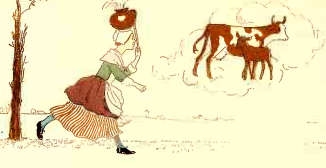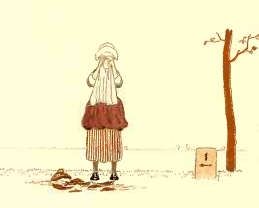Jean de La Fontaine: Fables
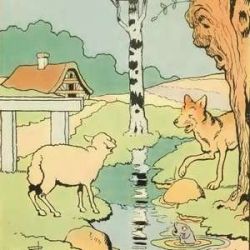
Who is Jean de La Fontaine?
Jean de La Fontaine (sometimes also called Jean de Lafontaine) is today most known by his Fables. La Fontaine's Fables are short stories in verses with strong morals and animals in leading roles.
If the Aesop is the first name to be associated with fables, we can probably say La Fontaine is the best among all fabulists.
His satirical, witty, sometimes cynical and always humorous presentation of life belongs to the top classic works of world literature.
(intro image by Benjamin Rabier, all images are public domain, sources: Archive.org and Wikipedia.org)
Jean de La Fontaine is...

Jean de Lafontaine
La Fontaine is not known by original stories. Plots and characters from his fables are heavily borrowed from other authors.
It was his style, efficient and classy, and ironic view on relations in society which distinguishes him from others. His position in French literature is similar to Shakespeare's in English. And we all know how intense competition both have...

Fontaine's biography
Jean de La Fontaine was born on 8th July 1621 and died on 13th April 1695. His family was relatively affluent and according to some sources their ancestors belonged to nobility.
Anyway, Jean de La Fontaine wasn't the perfect solution for succeeding his father's business (his father was government official: forest inspector). Jean started studying theology but dropped it after a yer and few months because this study didn't fit with his hedonistic lifestyle.
He eventually became a lawyer but never worked (just like his contemporary Charles Perrault and many others) in this field.
His father arranged a marriage between then 26 years old Jean and only fourteen and a half years old Marie Hericart. The couple didn't fit. Jean de La Fontaine was not a family man and he was spending too many nights out to keep his marriage in which one son was born.

Jean's and Marie's relationship resembled the fable about the ant and the grasshopper in many ways. Despite he was so much older, Lafontaine was the one in the role of the grasshopper.
The couple officially separated after ten years but Jean occasionally still visited Marie and wrote her many letters, but their son was entirely raised by her.
These letters are part of his literary heritage. Of course La Fontaine became immortal by his other writings...


La Fontaine's Tales
Yes, La Fontaine's first major work were Tales, not Fables. Tales with original title Les contes were written after readings of Boccacio and some other writers. Jean took the same plots and rewrote them in verses, added some allusion on contemporary situations, an original twist or pun or two and - voila!
His Tales were pretty popular among readers although critics didn't share their enthusiasm. La Fontaine also had a lot of trouble with censorship, especially with the church and king Louis XIV didn't approve his work what caused him trouble when he wanted to join the French Academy.
On the other side most of top painters from that time were more than willing to illustrate Fontaine's Tales. They were that good!
Lafontaine's Tales Gallery
Click thumbnail to view full-size









In the gallery above we can check some illustrations from La Fontaine's Tales made after drawings by different famous french illustrators from 17 century.
All are engraved by Francois Depollier.
Original stories were pretty saucy and Lafontaine surely added some additional spice so I definitely had some trouble to select ten G-rated illustrations...

La Fontaine's patrons
La Fontaine wasn't very businesslike. When he became forest inspector, soon got into debts. Jean de La Fontaine was more interested in poetry than business. Fortunately he was introduced to Nicolas Fouquet who granted him nice pension on pretty easy condition: La Fontaine was obliged to write at least one poem every three months.
When Fouquet got into trouble and Louis XIV musketeers arrested him (the story about Fouquet inspired the novel about The Man with Iron Mask), La Fontaine got new patrons. First was Duchess of Orleans and after her death Marguerite de Le Sabliere who invited him to stay in her guest house as long as he wants.
He did - for the rest of his life.
Jean de La Fontaine: Fables - free for your Kindle
Many of La Fontaine's Fables are part of our everyday's lives and knowing them really belongs to general education.

Life of an artist ...
Lives of many writers in past were dependent on mercy of rich and affluent people, mostly nobility. Jean de La Fontaine was one of many artists seeking his place in times of Louis XIV. Few centuries later the situation didn't change much. Hans Christian Andersen was in quite similar situation for the most of his life.
Madame the Montespan, one of La Fontaine's patrons - Most influential king's mistress


Fables by Jean de La Fontaine
Lafontaine's Fables were originally published in twelve separate books. First six were dedicated to king's son, next five books were dedicated to king's mistress (!) Madame de Montespan and the last one to king's grandson.
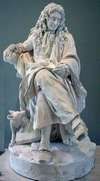
La Fontaine and religion
Jean de La Fontaine's life was far from moderate or even exemplary.
But in last years of his life he finally found his religion. The shift in his attitude was so strong, he - persuaded by priests - abandoned his Tales and Fables.
He even burned his last comedy before it was published, so we will never know what it was about. Fortunately we can still enjoy in Fontaine's masterpieces.
After all - he was a master of observing human nature
The Cat Transformed Into A Woman - illustrated by Arthur Rackham

This is classic fable by Jean de La Fontaine. It is a cautionary tale which warns against upstarts who wanted to climb up social ladder by marriage.
Do you know many phrases we use in our everyday's life origin from Fables by Jean de La Fontaine?
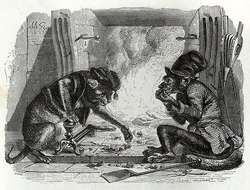
Monkey business
Monkey business meaning?
It seems monkey business is popular phrase but most of people really don't know where it comes from. It is hard to say if monkey business started in proverb which evolved into a fable or a fable was eventually reduced into a proverb / saying.
What we can say for sure the phrase and the fable is wrongly attributed to the collection of Aesop's fables although there is no known written version of the fable before 15 century.
Monkey business meaning can be understood on multiple levels but it always comes from the story about the monkey and the cat near fire where some chestnut is almost ready to be eaten. Somebody just have to put it out...

So monkey convinces the cat to do the painful job and promises her nice share of chestnuts. Of course the monkey keeps food for her and the cat just gets burnt paws.
La Fontaine popularized the fable with direct allusion on politics and the phrase monkey business is still mainly used in political or economic context.
When we talk about something as monkey business, we are saying somebody will use somebody else's work, knowledge, power... for his (probably selfish) goals without proper compensation.

Building castles in the air
or: »Building castles in Spain«
The phrase »building castles in the air« comes from folktale titled The milkmaid and her pail. This fable is often wrongly attributed to Aesop but is actually of Oriental origin. It's variants can be found in Panchatantra, Bidpai (Kalila and Dimna), Arabian Nights (aka 1001 Nights) and others).
In older versions it starts with a jar full of honey. The owner daydreams about selling the jar and buying some sheep with the money. Sheep will deliver lambs and soon his flock will be huge. So he could buy few cows, cows would deliver calves and soon he could afford to build a castle.
But in the meantime the jar dropped and daydreams never fulfilled
Building castles in the air - by Louis-Maurice Boutet de Monvel
Click thumbnail to view full-size







This powerful story about futility of daydreaming teaches us to stay in contact with reality and focus on today because we really don't know what tomorrow will bring.
The phrase building castles in the air was popularized with Jean de Lafontaine's Fables and he gets it from Bonaventure des Periers who probably heard the story from Spanish authors (so here we go with similar phrase 'building castles in Spain') who got it from Orient.
La Fontaine changed honey with milk and aimed it at the futility of daydreaming of alchemists who have spent entire lives to find the magic, instead of trying to achieve something through hard work.

The goose with the golden eggs
The phrase about the goose with the golden eggs is mostly expanded in 'kill a goose that laid a golden egg'.
It comes from an old fable about an owner (sometimes it is a couple with a goose (sometimes a hen) who laid golden egg and the owner presumed its inside must be all covered with gold.
When he kills the goose, he discovers the dead goose is really nothing special. The owner just lost the ability to get more golden eggs.

This story about greed is known all over the world and La Fontaine was one of last authors who opted for the message of warning against greed. Most of later versions decided for more regrettable tone but the moral is always similar - don't try to surpass the limits!
Of course the list of fables with morals and sayings which are now important part of our culture goes on and on...

The master of French language and perceptive observer of life La Fontaine was actually pretty absent- minded in everyday situations and his personal affairs.
Showing in public with his stockings turned inside out was only one of his usual eccentricities.
On one occasion he met his own son but didn't show any sign he recognized him. So somebody told La Fontaine he just chatted with his son...
»Oh, this is why he seemed so known to me!« said the writer and poet.
On another occasion La Fontaine visited his old friend. When he got at the door of his house, he was told this friend is already dead.
Lafontaine said: »Now I remember! I believe I attended his funeral!«
If you prefer pictures to text, these blogs are all about best vintage illustrations!
Additional resources
- Top illustrators and their masterpieces
Every post is about one important book, story or illustrator. Most of the presented illustrations are unique. - Meet the master of vintage picture books for kids!
Slightly different idea. One illustrator, one of his works and few short facts. For all the trivia lovers. - Vintage picture books for everybody
This blog is dedicated to the history of picture books. It's in Slovene language but you'll understand pictures anyway:)
















